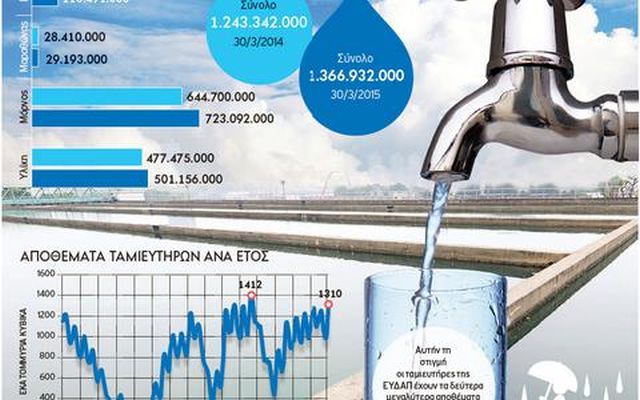It rained every second day during the past six months in many places in Greece.
In the period January-March, the rainy days on the island of Crete, in the city of Ioannina and in the area of the Aegean Sea in some cases exceeded the record rate of 50%, confirming the general impression that "it has been constantly raining since autumn".
The figures are indicative and they show the following: from October 2014 until yesterday, it rained 87 days out of 180 days in the city of Chania, Crete, 85 days in Lefkada, and 84 days in Ioannina. The result is increased water levels in the reservoirs of water supply company EYDAP. According to sources, the river Evinos has overflowed, and the official measurements show that water level in the reservoirs is the highest since 1985, with the exception of 2006, when it was record high.
On the other hand, the region of Serres is facing serious problems because of the floods. A state of emergency has been declared on Lesbos in the Aegean Sea, and the rains have caused serious damage, such as the collapse of the famous stone bridge in Plaka, Ioannina district.

Development and Construction Manager at water supply company EYDAP Konstantinos Vouiouklakis and researcher at the National Observatory of Athens Kostas Lagouvardis
As explained by Kostas Lagouvardis, a researcher at the National Observatory of Athens, who has provided the above data, "It is unusual that rains over the past six months were mainly reported in еastern Greece, in Chania and Sparta, and on the islands of Limnos and Naxos. Conversely, in western Greece, where traditionally it rains a lot, it rained but not at record levels this time. There was also intense snowfall. Furthermore, impressive results may not have been reported in northern Greece but in certain places, such as Veria, we had the wettest six months over the past six years..."
Cause
Analyzing the causes of the phenomenon, Kostas Lagouvardis notes that "in addition to the low atmospheric pressure, northern currents often influenced weather. This means that if the south wind were blowing it would have rained a lot in western Greece and less in the east as usual. This time, there was a combination of influences, so that when the wind blew from the north, the weather was fairly clear in western Greece but it rained in eastern Greece."
As a result of intense rainfall, water supply company EYDAP yesterday reported that it had in its reservoirs 123 million cubic metres of water more than in the same period last year.

Development and Construction Manager at water supply company EYDAP Konstantinos Vouiouklakis explains before the newspaper Ethnos the importance of this availability,
"In the area managed by EYDAP, i.e. in the region of Athens, water consumption is equal to about 400 million cubic metres per year. Therefore, having about 1.37 billion cubic metres of water available in our reservoirs today means that we will be able to cover the needs for water even if no raindrop falls over the following three years. This amount does not create uncertainty, as years such as 1991 are gone forever. What is required, however, is proper management of water resources, including combating leaks and the partial replacement of water meters, which we have already started, in order to avoid taking action at the last moment."
For his part, PhD George Karetsos, director of the Institute of Mediterranean Forest Ecosystems, stresses that the increased amount of rainfall does not necessarily mean a reduced possibility of fires in the summer. "It could even be the opposite, since rainfall favours the development of grassy vegetation. Grasses turn dry very easily, thus becoming true "wicks" for the occurrence and spread of fires. If the summer were rainy or if it rained at least 2-3 times in July, which would raise humidity, then there could be favourable conditions that would prevent a boom of fires in summer," George Karetsos explains for the newspaper Ethnos.